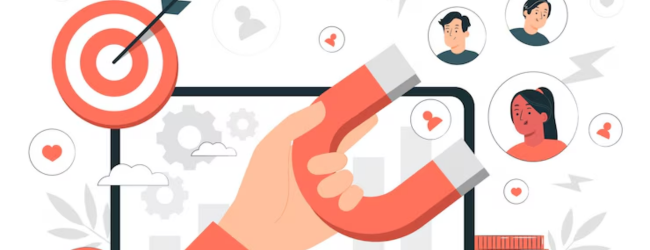Table of contents
- What is Push and Pull Marketing?
- How Push Marketing Strategy Works? (In Detail)
- Push Marketing Examples (In Detail)
- How Pull Marketing Strategy Works? (In Detail)
- Pull Marketing Examples (In Detail)
- A Detailed Step-by-Step Guide: Building a Synergistic Push and Pull Marketing Strategy
- Step 1: Define Your Target Audience (Deep Dive)
- Step 2: Set Clear, Measurable Objectives (Strategic Goals)
- Step 3: Choose Appropriate Channels (Strategic Selection)
- Step 4: Create Compelling, Integrated Content (Value and Persuasion)
- Step 5: Implement and Integrate (Execution and Synergy)
- Step 6: Measure and Analyze Results (Data-Driven Optimization)
- Step 7: Optimize and Iterate (Continuous Improvement)
- Need Expert Guidance?
- Conclusion
- FAQs
In the competitive world of marketing, businesses employ various strategies to reach their target audience and drive sales. Two fundamental approaches are push vs pull marketing. While both aim to influence consumer behavior, they differ significantly in their methods and objectives. This guide provides a comprehensive overview of push and pull marketing strategies, complete with examples, pros, cons, and a step-by-step guide to building effective campaigns.
What is Push and Pull Marketing?
- Push Marketing: A proactive strategy that involves “pushing” products or services directly to consumers through various channels, regardless of their immediate interest.
- Pull Marketing: A reactive strategy that involves “pulling” consumers towards a brand by creating valuable and engaging content that attracts their interest and encourages them to seek out the product or service.
How Push Marketing Strategy Works? (In Detail)
Push marketing focuses on getting your product or service in front of potential customers, often without their initial consent. It relies on direct communication and aggressive promotion to drive immediate sales.
- Key Characteristics:
- Proactive and direct
- Focuses on immediate sales
- Relies on widespread distribution
- Uses outbound marketing tactics
- Process:
- Identify target audience.
- Select appropriate push channels.
- Create compelling promotional materials.
- Distribute materials to target audience.
- Monitor and measure campaign performance.
Push Marketing Examples (In Detail)

- Television and Radio Advertising:
- Explanation: Broadcasting ads to a wide audience during popular programs.
- Detailed Insights: Effective for reaching mass audiences, but can be costly and less targeted.
- Direct Mail:
- Explanation: Sending promotional materials directly to consumers’ mailboxes.
- Detailed Insights: Allows for targeted messaging, but can be perceived as intrusive and has declining response rates.
- Telemarketing:
- Explanation: Making unsolicited phone calls to promote products or services.
- Detailed Insights: Can generate immediate leads, but often faces consumer resistance and regulatory restrictions.
- Point-of-Sale Displays:
- Explanation: Placing promotional materials at checkout counters or high-traffic areas in retail stores.
- Detailed Insights: Effective for impulse purchases and driving immediate sales.
- Trade Shows:
- Explanation: Exhibiting products or services at industry events to reach potential buyers.
- Detailed Insights: Allows for direct interaction with potential customers and generates leads.
Pros and Cons of Push Marketing
- Pros:
- Immediate sales generation
- Wide reach and mass exposure
- Effective for new product launches
- Cons:
- Can be perceived as intrusive
- Lower engagement rates
- Higher costs compared to pull marketing
- Can damage brand reputation, if done poorly.
ALSO READ | What is STP Marketing? A Complete Educational Guide for 2025
How Pull Marketing Strategy Works? (In Detail)
Pull marketing focuses on attracting customers by creating valuable and engaging content that meets their needs and interests. It relies on building brand awareness and trust to encourage customers to seek out the product or service.
- Key Characteristics:
- Reactive and customer-centric
- Focuses on building brand awareness and trust
- Relies on inbound marketing tactics
- Focuses on long term customer relationships.
- Process:
- Identify target audience’s needs and interests.
- Create valuable and engaging content.
- Distribute content through relevant channels.
- Optimize content for search engines.
- Engage with customers and build relationships.
Pull Marketing Examples (In Detail)

- Content Marketing:
- Explanation: Creating and distributing valuable content, such as blog posts, articles, and videos, to attract and engage potential customers.
- Detailed Insights: Builds brand authority and trust, drives organic traffic, and generates leads.
- Search Engine Optimization (SEO):
- Explanation: Optimizing website content to rank higher in search engine results, driving organic traffic.
- Detailed Insights: Increases visibility, attracts qualified leads, and improves brand credibility.
- Social Media Marketing:
- Explanation: Engaging with customers on social media platforms by sharing valuable content and interacting with followers.
- Detailed Insights: Builds brand awareness, fosters customer relationships, and drives engagement.
- Email Marketing (Opt-in):
- Explanation: Sending targeted emails to subscribers who have opted in to receive communications.
- Detailed Insights: Nurtures leads, builds customer loyalty, and drives conversions.
- Referral Marketing:
- Explanation: Encouraging existing customers to refer new customers through incentives and rewards.
- Detailed Insights: Leverages word-of-mouth marketing, builds trust, and drives customer acquisition.
Pros and Cons of Pull Marketing
- Pros:
- Higher engagement rates
- Builds brand loyalty and trust
- Lower costs compared to push marketing
- Attracts qualified leads.
- Cons:
- Longer time to generate results
- Requires consistent content creation
- Relies on organic traffic and engagement
A Detailed Step-by-Step Guide: Building a Synergistic Push and Pull Marketing Strategy

The most effective marketing campaigns often blend push and pull tactics to maximize reach and impact. Here’s a comprehensive, step-by-step guide to building a cohesive strategy:
Step 1: Define Your Target Audience (Deep Dive)
- Detailed Action:
- Go beyond basic demographics. Create detailed buyer personas that include psychographics, behaviors, pain points, and purchase triggers.
- Utilize market research, surveys, social listening tools, and customer feedback to gather in-depth insights.
- Map the customer journey to understand how your audience interacts with your brand at each touchpoint.
- Analyze your competitors’ audience to identify potential gaps and opportunities.
- Practical Example:
- If targeting young professionals, understand their preferred social media platforms, content consumption habits (e.g., podcasts, blogs), and their values (e.g., sustainability, convenience).
Step 2: Set Clear, Measurable Objectives (Strategic Goals)
- Detailed Action:
- Define specific, measurable, achievable, relevant, and time-bound (SMART) goals for both push and pull strategies.
- Align objectives with overall business goals (e.g., increase brand awareness, generate qualified leads, drive sales, improve customer retention).
- Establish key performance indicators (KPIs) to track progress (e.g., website traffic, conversion rates, social media engagement, lead generation costs).
- Determine how the push and pull strategies will compliment each other, for example, using push to promote pull content.
- Practical Example:
- Objective: Increase website traffic by 30% within three months using a combination of SEO (pull) and paid social media ads (push).
Step 3: Choose Appropriate Channels (Strategic Selection)
- Detailed Action:
- Select channels that align with your target audience’s preferences and behaviors.
- For push marketing, consider channels like paid social media ads, display ads, direct mail, and telemarketing.
- For pull marketing, focus on channels like SEO, content marketing, social media engagement, and email marketing (opt-in).
- Integrate channels to create a seamless customer experience (e.g., use push ads to drive traffic to valuable pull content).
- Consider the cost effectiveness of each channel.
- Practical Example:
- Use targeted Facebook ads (push) to promote a blog post (pull) that addresses a specific pain point of your target audience.
💡 Pro Tip: If you want to start a Business but have too many doubts, connect with a Manufacturing Business expert from Boss Wallah for guidance – https://bw1.in/1116
Step 4: Create Compelling, Integrated Content (Value and Persuasion)
- Detailed Action:
- Develop high-quality, valuable content for pull marketing that addresses your audience’s needs and interests (e.g., blog posts, videos, infographics, ebooks).
- Create persuasive promotional materials for push marketing that align with your brand’s voice and messaging.
- Ensure consistency in messaging and branding across all channels.
- Use push marketing to highlight the best pull marketing content.
- Practical Example:
- Create a series of blog posts (pull) on industry trends and promote them through targeted LinkedIn ads (push).
Step 5: Implement and Integrate (Execution and Synergy)
- Detailed Action:
- Execute your push and pull marketing campaigns according to your strategic plan.
- Integrate your campaigns to create a seamless customer experience.
- Use data from your pull marketing efforts to inform your push marketing campaigns, and vice versa.
- Use marketing automation tools to streamline processes and personalize interactions.
- Practical Example:
- Use email marketing (pull) to nurture leads generated from a paid social media campaign (push).
- Retarget website visitors who read a specific blog post (pull) with a relevant display ad (push).
Step 6: Measure and Analyze Results (Data-Driven Optimization)
- Detailed Action:
- Track key performance indicators (KPIs) for both push and pull marketing campaigns.
- Use analytics tools to measure website traffic, conversion rates, social media engagement, and lead generation costs.
- Analyze data to identify trends, patterns, and areas for improvement.
- Use A/B testing to optimize content, messaging, and channel selection.
- Practical Example:
- Analyze website traffic data to determine which blog posts (pull) generate the most leads and adjust your paid social media campaigns (push) accordingly.
Step 7: Optimize and Iterate (Continuous Improvement)
- Detailed Action:
- Continuously refine your push and pull marketing strategies based on data and feedback.
- Stay up-to-date with industry trends and best practices.
- Experiment with new channels and tactics to identify what works best for your brand.
- Regularly review your buyer personas, and adjust the marketing strategy accordingly.
- Practical Example:
- Adjust your social media content strategy (pull) based on audience engagement metrics and feedback.
- Change the wording, or visuals of paid adds (push) based on A/B testing results.
Need Expert Guidance?
Starting a business can be challenging, but you don’t have to do it alone! At Boss Wallah, our 2,000+ business experts are ready to provide valuable insights and guidance. Whether you need help with marketing, finance, sourcing, or any other area of any business, our business experts are here to help you succeed- https://bw1.in/1116
Confused about Which Business to Start?
Want to start your own business but unsure which one to choose? Explore Boss Wallah, where you’ll find 500+ courses by successful business owners, featuring practical, step-by-step guides on starting and growing various businesses. Find your perfect business idea today – https://bw1.in/1111
Conclusion
Understanding the differences between push and pull marketing is crucial for developing effective marketing campaigns. By strategically combining both approaches, businesses can maximize their reach, engage their target audience, and drive sustainable growth.
FAQs
- What is the main difference between push and pull marketing?
- Push marketing proactively pushes products to consumers, while pull marketing attracts consumers with valuable content.
- Which strategy is more effective?
- Both can be effective; the best approach depends on your target audience, objectives, and budget.
- Can push and pull marketing be used together?
- Yes, integrating both strategies can maximize reach and impact.
- What are some examples of push marketing?
- Television ads, direct mail, and telemarketing.
- What are some examples of pull marketing?
- Content marketing, SEO, and social media marketing.
- Which strategy is more cost-effective?
- Pull marketing is generally more cost-effective in the long run.
- How do I choose the right marketing strategy?
- Consider your target audience, budget, and marketing objectives.
- What is the most important part of a pull marketing strategy?
- Creating high quality, valuable content.


